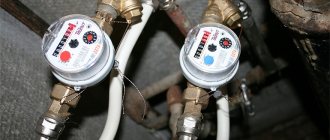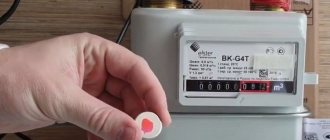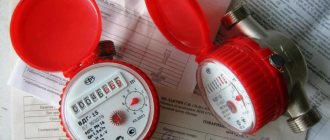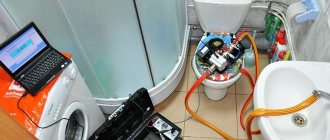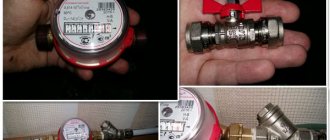Electricity meters are an integral attribute of any electrical network. They keep records of energy consumption, based on the results of which payments are made to the electricity supplier. Therefore, any operation of any equipment and devices in an apartment building, private house or outbuilding without a meter is prohibited. Like any measuring instruments, electric meters have a certain service life and mandatory verification, which establishes the measurement error.
Types of meters
The first devices for metering consumed electrical energy (electricity meters) appeared at the end of the nineteenth century. These were rather bulky devices with low accuracy and large dimensions. When the operation of meters was based on the principle of electromagnetic induction, the devices became structurally simpler, weight and dimensions decreased, and accuracy increased.
Such electricity meters operating on this principle are called inductive meters. Until recently, they were the most common devices for metering consumed electrical energy.
When an electric current passes through the inductors located in this meter, an inductive electromagnetic field is created. This field causes the metal disk to rotate. The greater the passing current, the more intense the electromagnetic field, the faster the disk rotates. The amount of electricity consumed is calculated by the number of revolutions of this disk.
Until recently, one of the most common counters was SO I446. Thanks to its simple design, it has a long service life, but it also has a number of disadvantages. These are: low accuracy class 2.5, low protection from external interference and an increase in reading error at low loads.
It was replaced by a new induction meter - CO M505. It already has an accuracy class of 2.0, and its service life is 32 years.
In addition to induction-type devices, electronic meters have recently found increasing use. Their big advantage is high accuracy. Due to the absence of mechanical moving parts in the design, a long service life of at least 25 years is ensured. Such electricity meters can be multifunctional and programmable. For example, keep track of energy consumption at several tariffs: day and night. However, due to their high price, it is advisable to install them only in industrial and office premises.
Electronic devices usually have an LCD digital display, and some models allow metering data to be taken remotely. It should be noted that, in addition to single-phase electricity meters, there are three-phase measuring devices. They are installed where there is a three-phase electrical line necessary to power the equipment: industrial and commercial premises, office buildings and the like.
Electricity metering devices also differ in accuracy class. According to the latest rules, for apartments and private houses, a device with an accuracy class of at least 2.0 (2% error) is sufficient.
The electricity meter located at the entrance to an apartment building must already have an accuracy class of 1.0. There are also more accurate devices of class 1.0, but they are no longer used for home purposes, but for industrial purposes.
Electric meter service life: when should you change your electric meter in 2019?
To carry out accounting and tariffication of electricity, meters were created; they have been used for more than a century. In 2020, such devices are for induction and electronic devices.
Due to their low cost and simplicity, devices based on the principles of inductance have become very popular since the twenties of the last century.
But now the power of household electrical appliances is growing rapidly. This has led to the need to improve methods of electricity metering, the use of several tariff plans, and such devices are being replaced by electronic devices.
Recently, the question of how long the electric meter lasts and when it needs to be changed is one of the most frequently asked questions.
Citizens often doubt the need to replace appliances and suspect management companies of a bad way of making money.
This is due to the fact that people are intrusively offered to buy devices from a specific seller. But the meter itself and the service for replacing it are not cheap.
Therefore, you should figure out how long it takes to change electricity meters, and under what conditions such a procedure is done.
Types of counters
As mentioned above, there are two types of counters:
- inductive;
- electronic.
Inductive devices operate on the principle of electromagnetic induction . The principle of their operation is the passage of current through inductors.
An electromagnetic field is created around them. It is this that causes the metal disk, which is connected to the counting mechanism, to rotate.
Simultaneously with the increase in electricity consumption, the amount of current that passes through the coils increases, and with it the electromagnetic field increases. Thus, the disk begins to rotate faster.
The number of its revolutions takes into account the counting mechanism, by which a person finds out how much energy has been consumed.
Thanks to the simple mechanism, the meter had a long service life. The disadvantage was that with small loads the errors increased and there was no protection against intervention.
Therefore, over time, the outdated model was replaced by a new device, the accuracy class of which was 2.0.
Electronic metering devices are characterized by a high accuracy class and long service life. The service life of the device has increased to 25 years due to the absence of moving mechanisms.
Due to the programming of the meter, it is possible to control energy consumption at night and day rates. Such devices have a high cost; most often they are installed in the office or in production.
Electronic meters are produced for three-phase and single-phase networks. If a meter needs to be installed in an apartment building at the input, then its class must correspond to indicator 1.0.
How long does it take to change the electric meter in an apartment?
In accordance with regulations, the service life of an electric meter is limited by device failure or the end date of the calibration interval, which is about 16 years.
Then the metrology service gives an opinion on whether it can be used in the future.
In 2020, Gosenergonadzor authorities are installing new equipment, even when the deadline for replacing electric meters is far from the deadline.
This decision is regulated by the Decree of the Government of the Russian Federation of 2012, according to which, accounting for the amount of energy that is used must be carried out with devices that have an accuracy of at least second class.
Faulty appliances or electricity meters whose service life has expired must be replaced, which will be done at the expense of the owner of the residential premises.
If tariff devices are not the personal property of consumers, but are installed on a staircase or in other public places, then all costs related to their replacement, repair, use are borne by the organization or owner on whose balance sheet they are located.
If the shelf life of the device has expired, its replacement is regulated by Article 543 and Article 210 of the Civil Code of the Russian Federation, Federal Law No. 261 and Government Decree No. 354.
Meter usage period
All control devices have a note in their passport indicating that a check was carried out, based on the results of which the meter is allowed to operate.
There is another mark nearby indicating when the next test should be carried out.
At the same time, the question often arises as to why additional verification is needed if the passport indicates the expiration date of the electric meter in the apartment.
Any electric meter has its own service life and expiration date. It is important to consider that these are not the same thing.
https://www.youtube.com/watch?v=_w4ExyMzpyQ
In most cases, the period for replacing the electric meter in an apartment should be after 25 years. The operating period is shorter.
This fact is explained by the fact that the device is constantly in operation and this affects the wear of its parts. This is often observed in induction models.
After a certain period of time, the meter begins to show a significant percentage of error . To detect this in a timely manner and carry out repairs, a calibration interval is established.
This means that after some time, the manufacturer does not guarantee accurate readings unless a control check is carried out.
For each model, the verification interval is not the same; it is reflected in the device passport.
The calculation of the interval begins from the moment the device is put into operation, but not from its purchase or production date. Eg:
- For single-phase models it is 2 years.
- For three-phase meters - 1 year.
If during the time indicated above the device has not been put into operation, it cannot be used for accounting without a new state inspection.
In an apartment or private house, a control inspection should be carried out by service employees every 6 months. At other facilities, inspection is allowed after one year.
Basic requirements for devices
Any electrical appliances, regardless of where they are installed, are subject to the same requirements:
- The device must be certified, otherwise its use is impossible.
- After the replacement procedure is completed, the new device is registered. The owner of the product and a representative of the energy company must be present.
- You can start using the meter only after it has been sealed by a representative of Energosbyt, who issues written permission to do so. In this case, the seal must already have one state inspection seal.
- The owner is returned one copy of the acceptance certificate indicating the device number. To avoid misunderstandings, it is better to immediately check whether the number on the act matches the one on the meter.
- Regardless of which meter was chosen, it is installed at a height of 1.7 meters in a dry place accessible for maintenance. The device can hang on the wall or be hidden inside an electrical cabinet. It is best if the ambient temperature is not lower than 0 degrees.
- The meter is connected only with a single wire, without any connections. In the case when during replacement it is necessary to move the wire to another place, it is allowed to cut the wires to extend them. The connection sections are connected via an automatic machine. It is closed in a box and also sealed along with the meter.
These are the basic rules that every electricity consumer must follow.
How to replace a meter
After a certain time, any counter has to be changed. The main reasons for this are failure of the device or expiration of the test period.
If an electricity meter is installed in a private house or apartment, it is considered the property of the owner. Therefore, its replacement will be at the expense of the home owner.
This also applies to sending the product for state inspection. When the meter is changed at the input of a high-rise building, all costs will be borne by the energy company.
Basic replacement rules:
- To replace an appliance at home, the owner must contact the electricity supplier with an application. It is strictly prohibited to remove the meter yourself.
- You can do simple work yourself, but a representative must be present. This is necessary for sealing.
- If, according to external signs, the old device appears to be faulty, then it is better to purchase a new one than to deliver the old one for inspection to receive a receipt, which will confirm its failure.
- The old meter must be removed by a specialist. After the procedure, he will make an appropriate entry about this in the account book.
When faced with a replacement or government audit, it is important to know your rights. Service representatives have authority only near the meters, and if they are located outside the residential premises, then all costs are borne by them.
If the device does not pass the test, then the citizen is given 1 month to bring it into compliance with the current rules.
Payment for this period is made based on the average for the last 6 months.
Thus, the service life of the electric meter depends on its model . On average, manufacturers set a shelf life of 25 years.
This means that after the specified period of time, the manufacturer does not guarantee accurate readings. In this case, a control check is required.
The calibration interval may differ, depending on the model of the device; it is reflected in its passport; it can be 1-2 years. In residential premises, representatives of the service authority are required to conduct inspections every 6 months.
The meter needs to be replaced if its service life has come to an end or when the device has stopped working due to a breakdown . According to the law, replacement occurs at the expense of the owner of the apartment or house.
In addition, in accordance with Government Decree No. 530, each consumer must use a device with an accuracy class of at least two. If this indicator is less, then the device should be replaced.
Source: https://zaschita-prav.com/srok-sluzhby-elektroschetchika/
Is there an expiration date
Due to the simplicity of their design, the service life of induction meters is quite long and is at least 30 years, and for electronic metering devices at least 25 years. The exact service life is indicated in the manufacturer's passport for the product. During this time, the meters are checked to confirm their serviceability and the veracity of the readings.
But there are some details you should know. Devices with accuracy classes 1.0 and 2.0 have an average shelf life of 16 years from the date of commissioning. Please note that the period is calculated not from the moment of manufacture, but from the moment the measuring device is turned on. Devices with accuracy class 2.5 are used until the verification period has expired. This means that the operation of such a device is allowed until the error measurement carried out by the metrological service exceeds the permissible threshold.
The verification date is indicated in the passport for the measuring device. In addition, metrological services can verify the device at the request of the consumer if there are suspicions that its readings are inaccurate. Organizations serving electrical networks also have the right, if necessary, to verify electricity meters. If, as a result of verification, the error exceeds the permissible threshold, the metering device must be replaced.
Calibration intervals and service life
The calibration interval is several years and depends on the service life of the electric meter set by the manufacturer. The service life for a batch of products (design), in turn, was set depending on the operating conditions for which the meter was intended.
To work in difficult conditions, the meters were made of high-quality materials and served for a long time. But such counters were very rarely found in retail trade. For apartments where the operating conditions for electrical equipment are quite comfortable, they made cheap devices with a short service life. For uniformity, several standard inter-verification deadlines have been established.
Typically, the period between verifications of mechanical induction meters is 8 years. The service life of the meter is 16 years. Electronic meters have a verification period of 16 years, and their service life is 32 years. That is, each device is verified twice: first at the manufacturer, and then in the middle of its service life.
Some electronic meters of accuracy class 1, for example Mercury 230 and 231, Energomera CE102 and CE301, are verified once every 10 years, and their service life is the same 32 years.
How to make a replacement
When the service life of an electricity meter has expired, or it has not passed routine verification, it is necessary to replace it.
If this device is located in a privatized apartment or in a private house, then it is considered the property of the owner of the premises. In this case, all costs for its verification and replacement are borne by the home owner.
If the metering device is located outside the residential premises, for example, on a staircase landing, the costs of this work are borne by the electricity supplier.
In the first case, it is necessary to write an application to the organization that provides the supply of electricity in the approved form. Although the work itself is not technically difficult and can be done independently, it is necessary to invite a specialist from a service organization. This is explained by the need to seal the meter and register it.
Stage 1 – Approval
Nothing can be changed without approval from network services, so the first steps should be the following:
- Contact the energy sales office, submit in person or send via mail an application for a replacement, indicating the address and reason for the replacement;
- Wait for an answer, check with the dispatcher about the electrician’s arrival time;
- Certify the malfunction of the device;
- Get permission to replace.
Read here! Thermostat for heater - overview of models and connection options. TOP best manufacturers + instructions for beginners
Important! If you notice a violation of the integrity of the seal, then immediately contact the control room, since concealing such a fact is punishable by administrative liability, court and a fine.
Story
The vast majority of apartment buildings built in Soviet times use meters with a power of 5-20 amperes and an accuracy of 2.5 points. The average life of the device is about 30 years with inspection every 7-13 years depending on the equipment model.
This was quite enough for the needs of the Soviet people. But in the last decade, thanks to general computerization and technology development, the load on the electrical network has increased.
These electric meters are not designed for modern electricity consumption by the population. Abuse leads to short circuits and sad consequences.
The reason in this case lies not only with the end consumer, but also with the technical equipment of the apartment. That is why in 1997 the production of devices with similar characteristics was banned. They were replaced by devices with an accuracy class of at least 2.0.
ATTENTION! Large differences in the accuracy class negatively affect the calculation of energy consumption and lead to increased costs.
Meter models for private homes
What are the features of electricity consumption in a private home? As a rule, this is a large number of electrical appliances, electricity-dependent systems and large areas of premises. Taking these characteristics into account, we select a counter.
Induction (mechanical) electricity meter
The operating principle is based on the action of current and voltage coils. The coils themselves are stationary, but the magnetic field generated by the coils sets the mechanical disk in motion. The counting mechanism of the device takes into account the number of disk revolutions and the amplitude of disk movement. The latter indicator is directly proportional to the power of energy consumed during the estimated time.
Features of operation.
- An undoubted advantage is reliability and long service life: even a 50-year-old “long-liver” can quite regularly produce kilowatts.
- However, mechanical devices are not very accurate and are not protected from unauthorized connections by third parties.
- They always operate in single-tariff mode, which does not allow optimal adjustment of energy consumption in the house.
Therefore, in recent years there has been a massive transition of consumers to electronic meters.
For reference! Modern types of metering devices have the function of setting according to tariff consumption. The essence of the work is to calculate the electricity consumed, breaking down the tariff by time period. There may be two, three, sometimes more.
Example.
Two-tariff recorders take into account energy at an expensive daytime tariff from 07.00 to 23.00, and at cheaper night rates - from 23.01 to 06.59. This mode is beneficial for a home equipped with powerful appliances, when energy-intensive systems operate at night.
Electronic electricity meters
They are equipped with microcircuits that calculate electricity directly and display digital indicators on an electronic display. Electronic recorders are represented by multifunctional devices capable of:
- store readings for a certain period of time in memory;
- transfer data automatically to the smart home system;
- accurately calculate electricity consumption taking into account appliances in “sleep” mode;
- work at several tariffs in two and three-phase modes.
According to manufacturers, the service life of electronic recorders is at least 15 years. In the Russian Federation this is still only a theoretical statement. But European experience has shown that chip meters are sensitive to the environmental conditions in which they operate.
In the Russian Federation, there are two types of electrical networks:
- single-phase with a rated voltage of 220 V;
- three-phase with a rating of 380 V.
The first type is the prerogative of household electrical networks in apartment buildings. This is the voltage that home appliances are designed for. The second type is designed for more powerful equipment of modern private households.
Source: PravoZhil.com
In what cases is replacement necessary?
Let's now find out in what cases and why the counter changes:
- Typically, devices are replaced when they have expired. The expiration date depends on the type and model of the device. Electronic devices typically have a shelf life of 25-40 years, while mechanical devices typically have a shelf life of 15-30 years. The exact date for replacing the electric meter is set by the device manufacturer, and this indicator itself is included in the technical passport of the mechanism.
- If the verification interval has ended. From time to time, government supervisory authorities conduct individual mandatory inspections to determine whether the device is in working order. Mechanical devices must be checked once every 8 years, and electronic devices - once every 16 years. If the verification interval has expired, then there is every reason to believe that the device is showing incorrect data, so the device needs to be replaced.
- The device needs to be replaced due to breakdown. A breakdown means the presence of mechanical damage to the meter (cracks, chips, broken display, violation of the integrity of the seal, and so on). The presence of a breakdown can be determined either by the owner of the device or by a special inspection commission. It should be understood that inspections can be carried out not only by state supervisory authorities, but also by representatives of the management company and firm. The management company checks the mechanical integrity of the device not too often (usually 1-2 times a year), and if breakdowns are detected, such a device must be replaced. When checking, a representative of the management company usually removes the seal and connects special electronic devices to the device to check the correctness of the displayed data. The measurement time is usually 10-30 minutes.
- The device is forced to be replaced if its accuracy class does not meet legal standards. In 2012, a law was passed requiring all electricity meters to have an accuracy class below 2.0. If a person has a device of lower accuracy (2.0 or higher) installed in a residential building, then he must replace the meter.
Shelf life and service life: what's the difference?
Each metering device has its own technical passport, which contains a mark from the factory laboratory about the tests carried out on the product and its approval for operation. Therefore, many people have a question about the need for additional checks given the expiration date of 20-25 years indicated in the passport.
The fact is that this shelf life should be distinguished from the guaranteed service life. After its release, the meter can lie in packaging for 5, 10, 15 or even 20 years, but it will still be considered suitable for installation if the established deadlines have not been violated.
Therefore, when assigning control checks, the reference point is the service life of the electric meter, which is associated with the intensity of work processes. After all, the conditions of use vary. One meter can be installed in a country house or in an empty apartment where electricity is rarely used, occasionally. The other, on the contrary, is in constant work and is subject to intense wear and tear. Induction devices, the main parts of which are in constant rotation, are especially affected.
After a certain period of time, the device will produce data with large errors, which will gradually continue to increase. For timely detection and elimination of the consequences of wear, an inter-verification time interval is assigned. Without this proof test, the instrument manufacturer does not guarantee its accurate operation after a specified period of time. The timing of such checks and complete replacement of electricity meters largely depends on the specific model and design features of a particular device.
Guarantee period
When purchasing an electric meter, the consumer is given a warranty card along with a passport. The period specified therein in most cases is five years. This is the time during which the owner of the device can contact the seller or manufacturer with complaints about detected defects in the device or demand free service.
If during the warranty period the device breaks down, or a defect is discovered during installation, the buyer can count on a replacement of the device. In this case, the buyer has the right to request an identical model or choose a different device in the store. If the device cannot be exchanged, the seller is obliged to return the money spent to the buyer.
A return of a low-quality electric meter can be made even after the end of the warranty period. The seller will be obliged to replace it if the buyer provides official evidence that the device has a manufacturing defect. To do this, you should first contact an expert to obtain an assessment of the origin of the detected defect.
